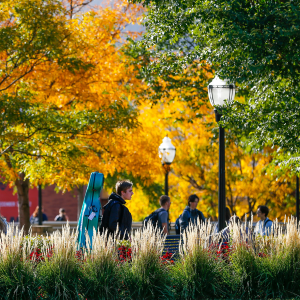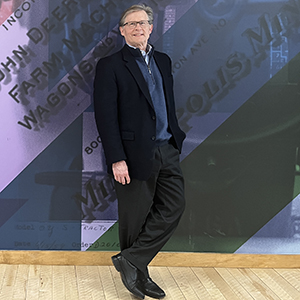Jeremiah Cunningham
A dainty butterfly flaps its wings, passing disinterestedly over spikes of green grass recently planted around an electrical substation. Jeremiah Cunningham, a student in the University of Minnesota’s Construction Management program, happens to be watching the tiny insect. He is onsite at one of Xcel Energy Inc.’s many substations as part of an eight-month-long internship, and his simple observation of the butterfly contributes to wheels of change beginning to be set in motion.
“I watched it pass over the new grass without stopping,” Cunningham says. “I suddenly realized the grass we’d been planting was far from appealing to pollinators.”
The traditional highway seed mix that Xcel Energy sows is reliable and it stems erosion, but, as Cunningham observed, it doesn’t contain the nutrients needed for wild pollinators in search of sustenance.
“When Jeremiah came on board he saw an opportunity to increase the use of pollinator-friendly seed when the company is restoring or reseeding a project site,” says David Butler, a supervisor of civil construction for Xcel Energy. “Jeremiah did a great job looking at all the different angles of what is needed to make something like this happen. He really took the initiative to research inside and outside the company to understand pollinator practices.”
“It was an amazing project to research: restoring land for corporate companies. Everybody wins.”
And so, what began as a Construction Management program internship requirement—a position working as assistant to Butler in Xcel Energy’s civil construction division—ballooned into a significant subproject with one ambitious goal: to help save wild pollinators.
“An internship can lead into unexpected territory,” says Peter Hilger, Faculty Director of the Construction and Facility Management Program at the University of Minnesota. “You never know what opportunities might come along that inspire you, or what discoveries you might make both about yourself and the business.”
Research and Rescue
“I did a lot of research through the U,” Cunningham says. “I also used a landscape design company as a resource to learn about plants and grasses native by county around Minnesota.”
He goes on: “Did you know there used to be 18 million acres of tall grass prairie in Minnesota and 240 million acres including other states and Canada? Today only one-tenth of one percent of that biome remains. Consider how expanding planting pollinator-friendly prairie grass on energy grounds would help save our wild pollinators.”
A full-fledged pollinator initiative based around Xcel Energy’s substation sites falls in line with Xcel Energy’s other pollinator-supportive projects, such as the restoration of native prairie land around the High Bridge Generating Station in St. Paul in 2008, or Xcel Energy’s 2015 Pollinator Pledge to work with the U.S. Fish and Wildlife Service identifying at least 50 acres of pollinator-friendly habitat in the St. Croix region.
Cunningham collaborated with Xcel Energy departments working on the pollinator initiatives, including the Siting and Land Rights Department to look for ways to transform the vegetation around substations to support pollinators.
Currently, wild pollinators are dying off in unprecedented numbers. Their disappearance can be directly attributed to a number of factors, including a shortage of environments such as native prairies with wild flowers—leading to a consequential shortage of nectar.
“It was an amazing project to research: restoring land for corporate companies. Everybody wins,” Cunningham says. “In addition to creating nectar corridors for pollinators like bees, butterflies, bats, and hummingbirds, prairie grass helps pull tons of carbon out of the atmosphere every year. For Xcel Energy, a company whose motto is ‘responsible by nature,’ this plan makes total sense.”
“If this moves forward, I’ll be so happy. As someone who loves the outdoors, any way I can make a difference, I’m all for it.”
Butler agrees. “Xcel Energy is excited to continue to expand its pollinator initiative program,” he says. “We are always looking for new opportunities to include native prairie plants and implement other environmentally sound practices at our current and future facilities.”
The best part of Cunningham’s recommendation to plant native prairie grass seed? It saves Xcel Energy money in the long run.
“Cost-benefit analysis is exactly what we teach in the Construction Management Program,” Hilger says. “Jeremiah weighed the pros and cons of planting wild prairie grass, and he understood that what tipped the scale was the fact that over time, it turned out to be cheaper to use native prairie grass instead of the traditional highway seed mix due to less required maintenance."
Using his construction knowledge, Cunningham mapped the scope of work that would be required for Xcel Energy to implement this initiative, and he presented his pollinator-prairie grass research to Butler. Then, as part of his internship program, he presented it to a larger group at Xcel Energy and to his teachers at the U’s Construction Management Program. He explained the idea to anyone who would listen. Eventually, he pitched the prairie grass idea to the project manager for a new substation in Monticello, Minn., who endorsed it to Xcel Energy managers.
“The way I see it, there are two solutions to saving wild pollinators,” Cunningham says. “Give them more land, and get energy companies involved. The best way to source available land is to use open areas around substations and under transmission lines.”
Land of Milkweed and Honey
It will take three to four years to get the prairie grass initiative rooted and thriving. If it works, Cunningham will be able to revisit that original substation and watch for butterflies. The insects would have a veritable buffet of milkweed and wildflowers to feast on.
“If this moves forward, I’ll be so happy,” Cunningham says. “As someone who loves the outdoors, any way I can make a difference, I’m all for it.”
This spring Xcel Energy will continue implementation of the native prairie grass and pollinator-friendly seed, including two new substation sites: one in Monticello and one near Chaska.
It’s all good news for Cunningham, whose research helped to contribute to saving the pollinators—all resulting in a classic butterfly effect.








